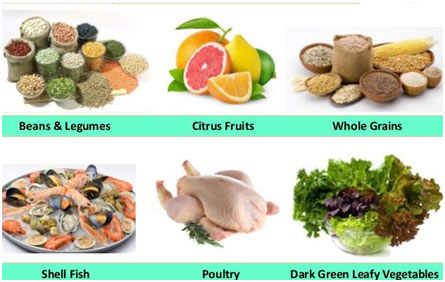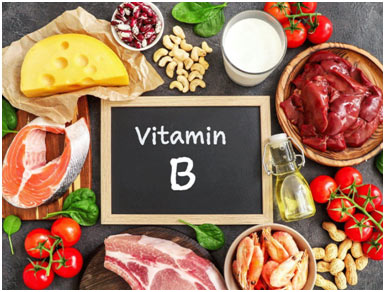Vitamin B Complex
B vitamins are a class of water-soluble vitamins that play important functions in the cell metabolic process and synthesis of red blood cells.
- Though these vitamins share similar names (B1, B2, B3, and so on), they are chemically unique substances that typically coexist in the same foods.
- In basic, dietary supplements including all eight are referred to as a vitamin B complex.
- Specific B vitamin supplements are described by the specific number or name of each vitamin, such as B1 for thiamine, B2 for riboflavin, and B3 for niacin, as examples.
- Some are more typically acknowledged by name than by number: niacin, pantothenic acid, biotin, and folate.
Vitamin B complex is composed of eight B vitamins:
- B-1 (thiamine)
- B-2 (riboflavin)
- B-3 (niacin)
- B-5 (pantothenic acid)
- B-6 (pyridoxine)
- B-7 (biotin)
- B-9 (folic acid)
- B-12 (cobalamin)
B-1 (thiamine)
Thiamine consists of a pyrimidine ring attached to a thiazole ring by a methylene bridge. Thiamine pyrophosphate (TPP) is an active coenzyme form of vitamin thiamine. Vitamin B-1 is vital to the healthy growth and function of organs, including the brain and heart.
B-2 (riboflavin)
Riboflavin is a yellow substance (Flavus = yellow in Latin) including an isoalloxazine ring with a ribitol (sugar alcohol) side chain. Riboflavin is relatively heated stable but decomposes in the presence of visible light (photosensitive).
The body requires vitamin B-2 to break down fats and drugs.
B-3 (niacin)
Niacin is a general name for the nicotinic acid and nicotinamide, either of which may serve as a source of the vitamin in the diet. Niacin is a basic derivative of pyridine. The body needs niacin to preserve healthy skin, nerves, and digestion. Doctors in some cases recommend high dosages of niacin to assist enhance cholesterol levels.
B-5 (pantothenic acid)
The name pantothenic acid is derived from the Greek word ‘pantothene,’ implying from “everywhere” and provides a sign of the large distribution of the vitamin in foods. Pantothenic acid is formed by a combination of pantoic acid and β-alanine. Vitamin B-5 is important for the health of the brain and nervous system.
B-6 (pyridoxine)
Vitamin B6 consists of a mixture of 3 various closely related pyridine derivatives specifically:
- Pyridoxine
- Pyridoxal
- Pyridoxamine
All the 3 have equal vitamin activity, as they can be interconverted in the body. Vitamin B-6 assists the body to make new red cells, which carries oxygen throughout the body. It also helps keep the immune system strong.
B-7 (biotin)
Biotin was known previously as vitamin Biotin is an imidazole derivative. It includes a tetrahydrothiophene ring bound to an imidazole ring and a valeric acid side chain. Enzyme-bound biotin, biocytin is an active type of biotin. Biotin is covalently bound to an ε-amino group of lysine of an enzyme to form biocytin. Biotin is necessary for healthy hair, nails, and nerve function.
B-9 (folic acid)
Folic acid includes three parts, pteridine ring, p-aminobenzoic acid (PABA), and L-glutamic acid. In a folic acid particle, the variety of glutamic acid residues varies from one to seven. Folic acid usually has one glutamic acid residue. The body utilizes folic acid– or folate, its natural type– to make DNA and genetic material. During pregnancy, folic acid might lower the threat of certain abnormalities and defects.
B-12 (cobalamin)
Vitamin B12 bears a complicated corrin ring (consisting of pyrroles comparable to porphyrin), linked to a cobalt atom kept in the center of the corrin ring, by 4coordination bonds with the nitrogen of the pyrrole groups.
The remaining coordination bonds of the cobalt are related to the nitrogen of dimethyl benzimidazole nucleotide and the 6th bond is connected to either methyl or 5′- deoxy adenosyl or hydroxy group to form methylcobalamin, adenosylcobalamin, or hydroxy cobalamin respectively.
The body’s nerve and blood cells require vitamin B-12. Appropriate levels of B-12 likewise prevent pernicious anemia, which is a shortage of this nutrient.
Sources of Vitamin B

Lots of foods include B vitamins, which makes it simple to get enough from your diet. It’s best to get your B vitamins from a wide variety of food sources. This helps to guarantee you’re getting enough of each type.
You can find vitamin B in:
- Milk, cheese, eggs, liver, and kidney.
- meat, such as chicken and red meat.
- fish, such as tuna, mackerel, and salmon.
- shellfish, such as oysters and clams.
- dark green veggies, such as spinach and kale.
- veggies, such as beets, avocados, and potatoes.
- entire grains and cereals.
- beans, such as kidney beans, black beans, and chickpeas.
- nuts and seeds.
Multiple-Choice Questions (MCQs) with Answers
- What class of vitamins do B vitamins belong to?
- a) Fat-soluble
- b) Water-soluble
- c) Mineral
- d) Protein
Answer: b) Water-soluble
- How many vitamins are included in the Vitamin B complex?
- a) Five
- b) Seven
- c) Eight
- d) Ten
Answer: c) Eight
- Which vitamin is also known as thiamine?
- a) B-2
- b) B-3
- c) B-1
- d) B-5
Answer: c) B-1 (Thiamine)
- What is the primary role of vitamin B-1 (thiamine)?
- a) Breakdown of fats
- b) Formation of red blood cells
- c) Maintenance of healthy skin and nerves
- d) Oxygen transport in the body
Answer: c) Maintenance of healthy skin and nerves
- Which vitamin is photosensitive and decomposes in the presence of visible light?
- a) B-2 (Riboflavin)
- b) B-3 (Niacin)
- c) B-5 (Pantothenic Acid)
- d) B-6 (Pyridoxine)
Answer: a) B-2 (Riboflavin)
- What is the function of vitamin B-3 (niacin)?
- a) Preservation of healthy skin, nerves, and digestion
- b) Formation of red blood cells
- c) Breakdown of fats and drugs
- d) Oxygen transport in the body
Answer: a) Preservation of healthy skin, nerves, and digestion
- From the given options, which vitamin is known as Pantothenic Acid?
- a) B-1
- b) B-3
- c) B-5
- d) B-7
Answer: c) B-5 (Pantothenic Acid)
- Vitamin B-6 comprises a mixture of three closely related pyridine derivatives. Which of the following is NOT one of them?
- a) Pyridoxine
- b) Pyridoxal
- c) Pyridoxamine
- d) Pantothenic Acid
Answer: d) Pantothenic Acid
- What is the active form of Biotin, bound to an enzyme?
- a) Biotinoid
- b) Biocytin
- c) Biotinase
- d) Biotinol
Answer: b) Biocytin
- Folic acid includes three components: pteridine ring, p-aminobenzoic acid (PABA), and _____?
- a) Lactic acid
- b) Acetic acid
- c) L-glutamic acid
- d) Ascorbic acid
Answer: c) L-glutamic acid
- What does vitamin B-12 contain at its center, connected to a corrin ring?
Answer: c) Cobalt
- What is the primary role of Vitamin B-12 in the body?
- a) Formation of red blood cells
- b) Maintenance of healthy skin and nerves
- c) Oxygen transport in the body
- d) Blood clotting
Answer: a) Formation of red blood cells
- Where can you find Vitamin B in significant amounts?
- a) Seeds and nuts
- b) Dark green vegetables
- c) Fruits
- d) All of the above
Answer: d) All of the above
- What does Pantothenic Acid mean, etymologically?
- a) From “everywhere”
- b) Panoramic view
- c) Pancreatic origin
- d) Painless
Answer: a) From “everywhere”
- Which vitamin helps the body make new red blood cells and maintain a strong immune system?
- a) B-1
- b) B-6
- c) B-12
- d) B-2
Answer: b) B-6 (Pyridoxine)
- What is the role of Folic Acid during pregnancy?
- a) Enhance cholesterol levels
- b) Reduce the risk of certain abnormalities and defects
- c) Break down fats and drugs
- d) Maintain healthy skin and nerves
Answer: b) Reduce the risk of certain abnormalities and defects
- Which B vitamin is necessary for healthy hair, nails, and nerve function?
- a) B-5 (Pantothenic Acid)
- b) B-6 (Pyridoxine)
- c) B-7 (Biotin)
- d) B-3 (Niacin)
Answer: c) B-7 (Biotin)
- What is the common name for Vitamin B-9?
- a) Folic Acid
- b) Riboflavin
- c) Niacin
- d) Pantothenic Acid
Answer: a) Folic Acid
- Which B vitamin is relatively heat-stable but decomposes in the presence of visible light?
- a) B-6 (Pyridoxine)
- b) B-1 (Thiamine)
- c) B-2 (Riboflavin)
- d) B-5 (Pantothenic Acid)
Answer: c) B-2 (Riboflavin)
- What does the term “Flavus” in Latin, used in the context of B-2 (Riboflavin), mean?
- a) Red
- b) Blue
- c) Yellow
- d) Green
Answer: c) Yellow
- Which B vitamin is essential for the health of the brain and nervous system?
- a) B-6 (Pyridoxine)
- b) B-5 (Pantothenic Acid)
- c) B-12 (Cobalamin)
- d) B-1 (Thiamine)
Answer: b) B-5 (Pantothenic Acid)
- What is the role of Niacin in the body?
- a) Formation of red blood cells
- b) Preservation of healthy skin, nerves, and digestion
- c) Breakdown of fats and drugs
- d) Oxygen transport in the body
Answer: b) Preservation of healthy skin, nerves, and digestion
- What is the active coenzyme form of Thiamine (B-1)?
- a) Thiamine pyrophosphate (TPP)
- b) Thiamine monophosphate (TMP)
- c) Thiamine triphosphate (TTP)
- d) Thiamine diphosphate (TDP)
Answer: a) Thiamine pyrophosphate (TPP)
Wrap up
The Vitamin B Complex comprises eight water-soluble vitamins, each playing crucial roles in cell metabolism and red blood cell synthesis. These vitamins, named B-1 (thiamine), B-2 (riboflavin), B-3 (niacin), B-5 (pantothenic acid), B-6 (pyridoxine), B-7 (biotin), B-9 (folic acid), and B-12 (cobalamin), are distinct substances coexisting in various foods. Specific supplements are labeled by vitamin name or number, with some, like niacin, pantothenic acid, biotin, and folate, being more commonly recognized by name.
Each B vitamin serves unique functions:
- B-1 (thiamine) is crucial for the healthy growth and function of organs, including the brain and heart.
- B-2 (riboflavin) aids in breaking down fats and drugs, but is photosensitive and decomposes in visible light.
- B-3 (niacin) is vital for maintaining healthy skin, nerves, and digestion. High doses may be recommended to improve cholesterol levels.
- B-5 (pantothenic acid) is essential for the health of the brain and nervous system.
- B-6 (pyridoxine) helps produce new red blood cells and maintains a strong immune system.
- B-7 (biotin) is necessary for healthy hair, nails, and nerve function.
- B-9 (folic acid) is used to make DNA and genetic material, and during pregnancy, it may reduce the risk of certain abnormalities.
- B-12 (cobalamin) is crucial for nerve and blood cell health, preventing pernicious anemia.
Sources of Vitamin B include a variety of foods such as milk, cheese, eggs, liver, meat, fish, shellfish, dark green vegetables, beets, avocados, potatoes, whole grains, cereals, beans, nuts, and seeds. It is recommended to obtain B vitamins from a diverse range of sources to ensure adequate intake of each type.

